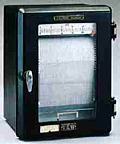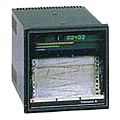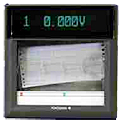The B9565AW Story
The Z-fold recording chart paper invented by Yokogawa in 1951 was the first example of its kind in the world. Mr. Arima, a Development Manager of Yokogawa, came up with the idea of the Z-fold recording chart paper which was inspired by the shape of “sutra”, canonical scriptures used in Buddhism.
The product enabled users to check the data whilst the recording was taking place, revolutionizing the monitoring processes and allowing the recorder to be used in industrial automation field such as power plants, chemical plants, and various in factories. By the 1970s, the Z-fold recording paper was used in most recorders in Japan and became a de facto standard for recorder manufactures globally.
In 1985, Yokogawa introduced the first ever microprocessor incorporated pen recorder, the µR100. Along with its 144x144mm DIN size, theµR100 had a microprocessor which allowed automatic linearization of signal from thermocouple or RTD (resistance temperature detector) sensors, scaling and transformation of input signals into physical values and a built-in LCD display of bar graphs and numerical data. It also enabled print outs of measured data, units, time, and measurement index on a recording chart paper.
The international success of the µR100 was underpinned by B9565AW, the Z-fold recording paper used in this recorder. B9565AW was developed by Yokogawa Electric and KOKUSAI Chart, a subsidiary company of Yokogawa Electric Corporation. The Z-fold recording paper allowed the operator to see the recorded data at anytime whilst the measurement was in process. With improved quality, the recording paper was temperature and humidity resistant, twice the length of the original prototype and requiring only monthly chart paper replacements.
When low quality recording paper is used, problems such as paper jamming, ink smearing/blotting and tearing at the perforations may occur. These faults are often incorrectly attributed as an instrument fault. Not only is this problematic for the users, but it is also a burden to the instrument manufacturers.
The use of a Z-fold recording paper which was twice the length of the original chart in the 100mm recording device was a risky decision. During the development phase of the µR100, various chart manufacturers’ recording papers were tested. These recording papers were not resistant to the high humidity/temperature climates of Japan and other Asian countries and did not meet Yokogawa’s stringent quality control (QC) standards.
As a result of a successful collaborative effort between Yokogawa’s R&D, KOKUSAI chart and a paper manufacturer (mother coil manufacturer), one of the finest quality recording paper was developed for the use in the µR100 recorder. B9565AW was the product of Yokogawa’s high QC standards and the dedication of KOKUSAI chart for its recording paper and processing technology.
KOKUSAI chart invested in various strategies, including research into paper humidity/temperature resistance, accuracy and angle testing of paper feed into recorders, as well as new packaging approaches for individual recording rolls, which all significantly contributed towards the improvement of the paper processing technology.

- B9565AW:Straight slant and clear holes
Ever since, B9565AW is the only recommended paper for Yokogawa’s 100mm effective recording length recorders (µR100, µR1000, µR10000, µRS1000). The technology and the high quality of recording papers produced by KOKUSAI chart are globally recognised and B9565AW is now an industry standard and one of the most widely used recording papers worldwide.

- ER Recorder

- Sutra

- μR100

- Jamming
